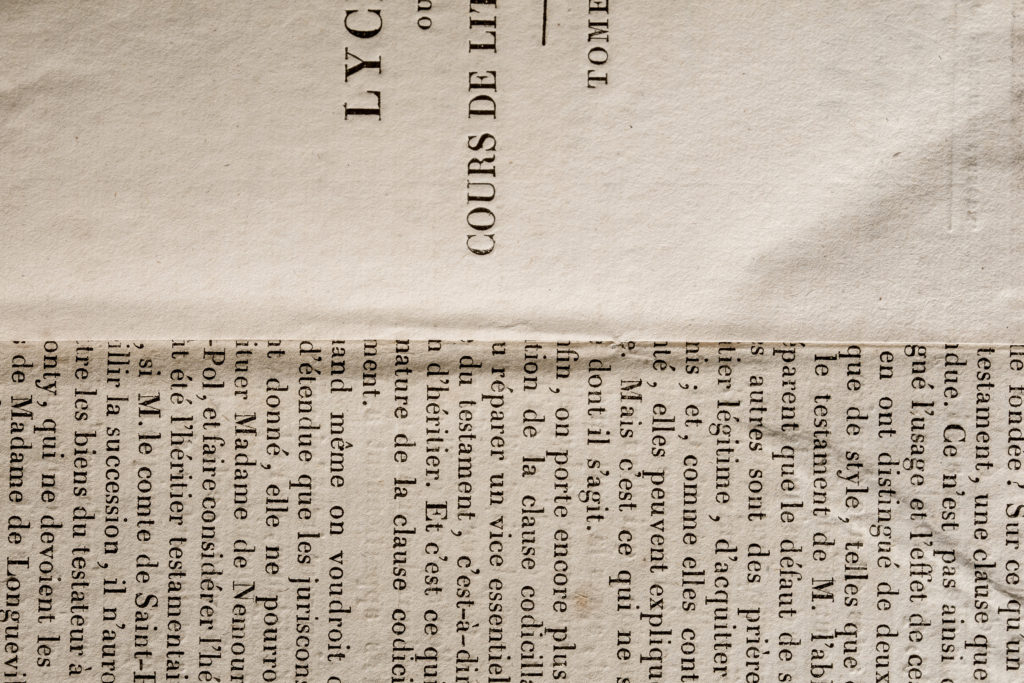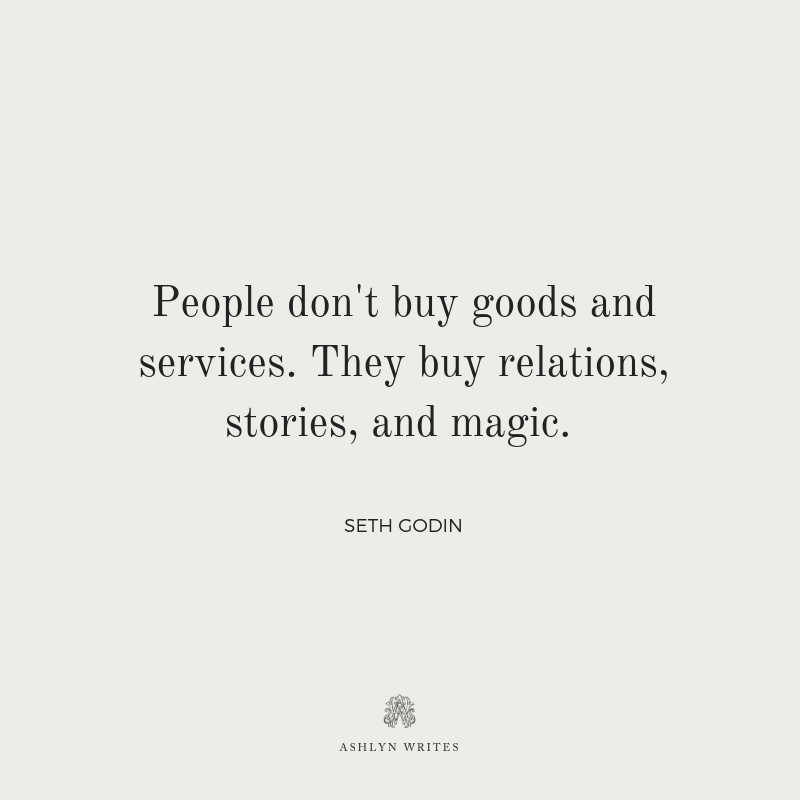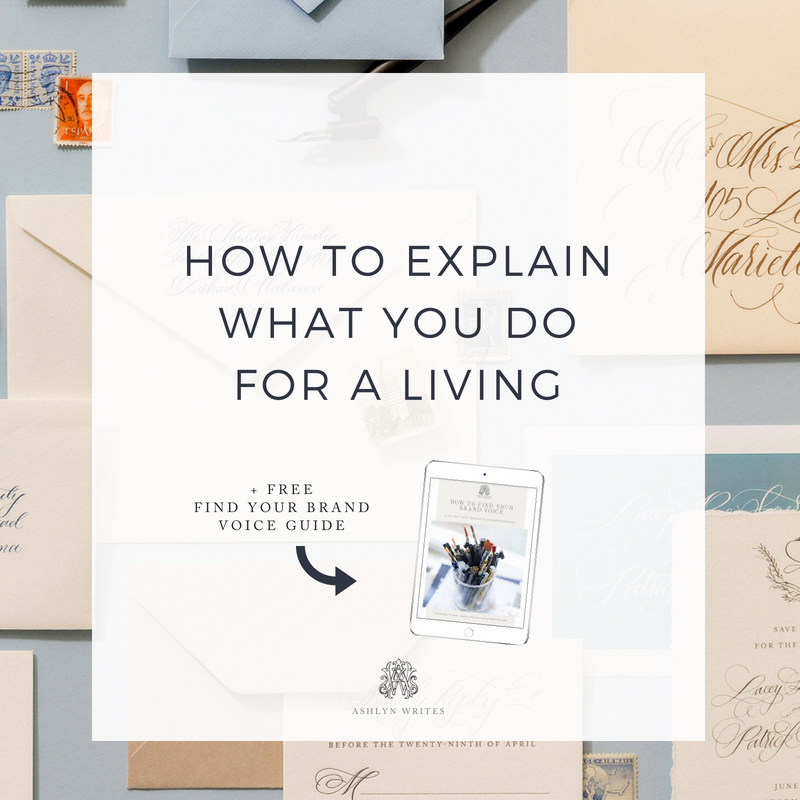We’ve all been at the cocktail party or family event when someone asks “now what is it that you do?”
(Awkward.)
Figuring out how to explain what you do for a living isn’t the easiest task in the world.
Meghan C. sent in a blog request saying, “I struggle with explaining what I do without taking more than 5 mins. I’d love to be able to just answer that question clearly and naturally!” Meghan, coming for you!

Today, we’ll talk through how to explain what you do for a living. You’ll learn:
- The 5 steps I go through when writing elevator pitches for clients
- Why it needs to be clear
- The tweak that most people aren’t doing to describe themselves
It’s the question that can stump and paralyze even the best of us. ???? Clearly knowing how to communicate on AND off paper what you do will make you SO much more confident when you have this ready.
These five steps to an elevator pitch of sorts are DEFINITELY not the only way for how to explain what you do for a living, but I hope it’s a starter formula for you if you can’t describe your job quickly.
I’m an introverted extrovert AND have struggled to answer this even though I’m a copywriter myself, and should know how to communicate … so I thought this would be good coming from me: somebody’s who’s messed it up, but finally hit a rhythm.
Now, I actually LIKE answering this question and explaining what I do confidently, so I have a list of five things I’m going to share with you that can help you explain your weird job. These are things that worked for me, and hopefully, they work for you, too!
Don’t forget to grab your freebie cheatsheet that goes with this video, the How to Explain What You Do Mini-Workbook.

VIDEO TUTORIAL
Step 1: Gather the essentials for your elevator pitch
First up in how to explain what you do for a living, we’ve gotta know a few things.
I want you to have on hand:
- Your name and rough draft “title” of what you do
- What is the problem you solve
- Who you help
- How you uniquely solve it
Now, you know your name, and again, we’ll dig into “title” of sorts in step three.
Sometimes, if we JUST say what we are, we feel like we didn’t REALLY say everything we do. Have you ever felt like that? Like you gave a one-word answer, and there’s SO much more that really goes into what you do? That’s why I’m asking you to gather the three other things.
BUT.
Before we move on …
That last essential is something we need to camp out on. In my signature Copywriting for Creatives™ program, and for all my clients, we dig in deep to your unique selling proposition—your onlyness factor, as I call it. If you can’t tell me why you do what you do in a way that’s different from anyone else (specifically if they’re more competitively priced than you), we need to sit there for a minute.
Speaking at Creative at Heart conference last year, I talked about this, and asked attendees “why should I pick you over your competitors.” Here’s what they’ve said:
- Because I actually care about the success of my clients’ businesses.
- Because I work with couples who want a marriage more beautiful than their wedding.
- Because I give them a super clear gameplan to nix the marketing overload.
Tough love moment.
Those sound good … really good. They’re noble, they’re lovely … and you can PROBABLY build a business foundation with that.
But they’re not really good enough.
Eek!
Why? Because they’re still not differentiating factors. My client Shay Cochrane of SC Stockshop gave a KILLER talk at the same conference, reminding business owners to go “3 deep” in your niche. She gave an example of a generic wedding photographer vs. a wedding photographer who grew up riding horses. She’s comfortable around them, so she starts to shoot weddings only at horse farms and for equine-loving couples.
Boom. She becomes the go-to-girl for equine wedding photography.
See what I mean? How can you become the only go-to girl for something? That’s one of the first things we need to know in how to explain what you do for a living.
Again, if you can’t tell me why you do what you do in a way that’s different from anyone else (specifically if they’re more competitively priced than you), we need to sit there for a minute.
Example 1:
- Calligrapher
- I noticed a need for calligraphy in Alabama that specialized in watercolor
- Classic, old-school paper-loving women in my area
- I developed an 8-step process that marries the love with watercolor elements, like their family’s home, locations around the state, or botanicals that mean a lot to them
Example 2:
- Essential oils business owner
- I saw moms that want to use safer cleaning stuff usually don’t trust that they work as well as more toxic options
- Helps mostly moms
- I provide weekly online essential oil classes and tools with my biochemistry background
Example 3:
- Gift box company owner
- I saw brides in the D.C. area trying to show-off our city with their hotel guest gift bags
- Brides in the D.C. area
- I curate and deliver custom gift boxes for weddings with ONLY locally-sourced items
Step 2: Prep your story.
Our brains love story! People instantly tie stories to themselves—so weaving story into describing what you do is a way to humanize yourself and not sound so robotic.
Now, remember why people ask this question in the first place—they want to connect with you! This is why I asked you to gather those 4 things in step 1: You probably had a winding path to get to where you were, and I wanted to remind you of that.
The anatomy of your elevator pitch’s story is in things 2, 3, and 4 of what I told you to gather:
- What is the problem you saw
- Who you help
- How you uniquely solve it

So, as we link these three things together, start with the end in mind—what’s the happily ever after? What’s the end result of your work? How can you string these three pearls together?
I have 3 examples for you:
A website designer might say, “I make websites organized and beautiful so small businesses can serve their customers.”
That essential oil business may say “Moms that want to use safer cleaning stuff usually don’t trust that they work as well as more toxic options, so I provide weekly online essential oil classes and tools with my biochemistry background.”
The gift box owner may say “I saw brides in the D.C. area trying to show-off our city with their hotel guest gift bags, so I curate and deliver custom gift boxes for weddings with ONLY locally-sourced items.”
We as humans like things that are clear and simple, and communicating what you do as a story
Step 3: The Cocktail Party Test
… or, maybe for you, it’s the Family Christmas Party Test, wink.
Just imagine that you’re at an event with real, live people.

Does anything that you have so far make you sound like a tool when you say them?
Choose your words carefully.
For example, let’s look at that title. Does it pigeonhole you? My own business is an example—sometimes, I say I’m a copywriter, and people have no idea what that is. So in many circles, I break it down even further at times and say, “I help write marketing words.” Another example comes from doing some research work recently for my copywriting client Julie Solomon. She serves online influencers, and we talked about that title … some of them experience a negative reaction to it, some of them say they’re a blogger, some of them say they’re a content creator, and some just own the phrase “online influencer” anyway!
See what I mean? Find the title that people understand, and don’t waste their time with jargon that doesn’t matter to them (ex. “copywriter” … why would I say that if I know there’s a 90% chance they’ll have no idea what I mean.). The more you talk and fill space makes you look less confident. Jargon can make you look insecure too.
This goes hand in hand with step 4 …
Step 4: Know your audience.
You be the judge on if you need context or not, and how advanced people are with understanding what you do.
Think about why people are asking what you do. People don’t like a sales pitch. Right?
People ask “what do you do” either out of genuine interest or sometimes probably just to be polite!
So many marketing gurus tell us to make our elevator pitch our sales pitch, which I don’t really agree with. In fact, Michelle Golden called this “in person spam” in a TED Talk. I personally think that if you’re clear about what you do, you position the problem you solve, people are smart enough to know if they have that problem or not.

We need to make it MORE about the person and the audience than you. Make it relevant to them! So, think about their goal:
So, think about their goal. For example:
- New friends at a creative conference are PROBABLY trying to find someone that they want to sit with for the day. They can probably take a bit more niche-specific detail.
- Your great aunts and grandparents want to make sure you’re doing something with your life and earning money, so you may be very simplified here, unless they ask for more detail.
- People on a tour group with you in a foreign country are probably just being nice, but probably have an array of business experiences, so land somewhere between the two extremes. 😉
We need to earn people’s trust. Knowing your audience when you explain what you do is one way to do that.
Lastly is the easy part …
5. Memorize it.
Wes laughed at me, but before my first creative conference, I sat on the back porch memorizing an elevator pitch for my new business. I knew that if anyone asked me what I did, I’d word vomit.
Again, I’m an extroverted introvert. I like to talk, but typically after I’ve processed a bit what I want to say.
Memorizing your elevator pitch is how you’re able to move and be fluid when people ask, and how you’re able to enunciate what you say.
Now remember, AS you commit this elevator pitch to memory, keep good cadence—don’t say it too quickly!
Sometimes you’ll be fine with just level 1.
Sometimes you need to add in level 2
Sometimes, you can add on level 3.
When you’ve got it memorized, this is easier.
Watch the video above to see me give my own elevator pitch.
Want to pocket this for later? Grab the freebie download version of this post, so you can keep this in your files—or use it to describe a course you’re launching, workshop you’re selling, etc.
Don’t forget to grab your mini-workbook that goes with this video, and if you need MORE help and examples, we have an item in my shop waiting for ya.
Okay, hit me in the comments! What’s YOUR elevator pitch?
Reading Time: 8 MinutesReading time: 8 min. We’ve all been at the cocktail party or family event when someone asks “now what is it that you do?” (Awkward.) Figuring out how to explain what you do for a living isn’t the easiest task in the world. Meghan C. sent in a blog request saying, “I struggle with explaining […]




Hey!!! Meghan C. that’s me 😉
This post was just what the doctor ordered. Here’s what I came up with:
Rental property owners have unique tax situations + investment needs, so I help them with their finances by creating a roadmap for them to follow so they have great rates of return + the confidence that they are on the right track…and someone to ask when they hit a roadblock
AH! Meghan, I was HOPING you’d see this! I think you nailed it. I am so impressed!! xx
I have been searching the internet for help with putting together my website for my massage business and I am so grateful to have run across your site. There is SO much to take in and this is only the first “guide” I’ve worked on since running into your site earlier today. So thank you, this was awesome, I really needed this and I think I have created something good, I know I’m pretty proud of it. I already had an elevator pitch that I have been using but it was such an umbrella pitch that, looking back on it now, almost any therapist could use. So I am so grateful that you’ve helped me take the time to think about it, and me, more closely.